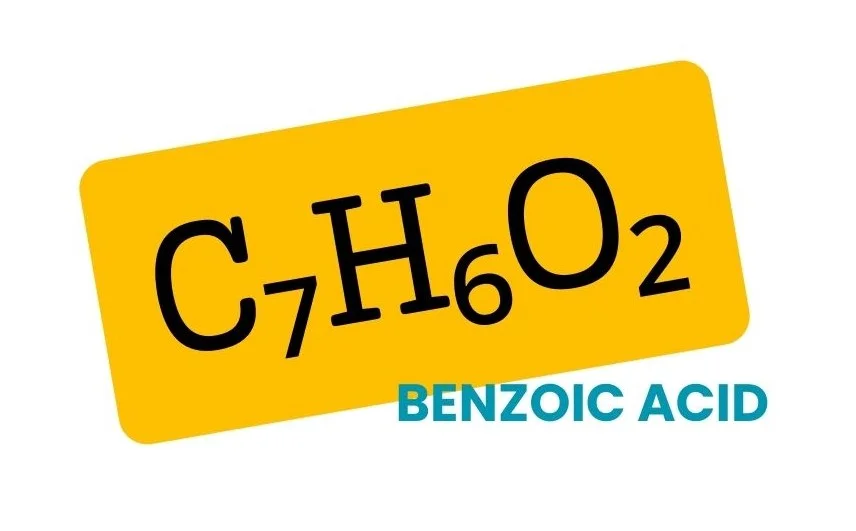Benzoicum Acidum, a homeopathic remedy derived from benzoic acid, holds a significant place in homeopathic practice, particularly for its profound effects on urinary and rheumatic conditions.
Prover: DR. JEANES
Member of Nash’s Trio
Dr. Jeanes highlights that this remedy is part of Nash’s trio of remedies known for their characteristic of offensive urine.
The other members of this trio include Nitric Acid and Sepia.
This association with Nash’s trio underscores the distinctive quality of the remedy’s action on urinary symptoms, particularly in cases where urine has an offensive odour.

Table of Contents
ToggleSOURCE INFORMATION
- Chemical Name: Benzoic Acid
- Chemical Formula: C₇H₆O₂
- CAS Number: 65-85-0
- Molecular Weight: 122.12 g/mol
Appearance: Benzoic acid is a white crystalline solid with a characteristic odour.
Solubility: It is sparingly soluble in cold water but more soluble in hot water, alcohol, and ether.
Natural Sources: Benzoic acid occurs naturally in various plants and fruits, including cranberries, plums, cinnamon, and cloves. It is also found in some resins and gums.
Synthesis: Commercially, benzoic acid is produced by the oxidation of toluene or benzyl chloride with potassium permanganate or chromic acid.
It can also be synthesized from the reaction of sodium benzoate with mineral acids.
Industrial Uses: Benzoic acid has numerous industrial applications, including:
- Food Preservative: It is commonly used as a preservative in food and beverages to prevent microbial growth and extend shelf life.
- Antifungal Agent: Benzoic acid and its salts are used in pharmaceuticals and personal care products as antifungal agents.
- Chemical Intermediate: It serves as a precursor in the synthesis of various organic compounds, including benzoyl chloride, benzyl benzoate, and pharmaceuticals.
- Flavouring Agent: Benzoic acid and its derivatives are used as flavouring agents in food, beverages, and tobacco products.
- pH Regulator: It is utilized as a pH regulator in cosmetics, skincare products, and industrial processes.
Medicinal Uses: In traditional medicine, benzoic acid has been used for its antimicrobial and antifungal properties.
It has also been investigated for its potential therapeutic effects in conditions such as hyper-ammonemia and urea cycle disorders.
Safety Considerations: Benzoic acid is generally recognized as safe (GRAS) when used in accordance with good manufacturing practices (GMP) as a food additive.
- However, excessive intake may cause adverse effects, and individuals with hypersensitivity to benzoates should avoid products containing benzoic acid.
- Regulatory Status: Benzoic acid is approved for use as a food additive by regulatory agencies such as the U.S. Food and Drug Administration (FDA) and the European Food Safety Authority (EFSA).
- It is also listed in the Pharmacopoeia of various countries for pharmaceutical applications.
- Environmental Impact: Benzoic acid is biodegradable and does not persist in the environment.
- It is considered low in toxicity to aquatic organisms but may pose risks if released in large quantities.
SPHERES OF ACTION
Benzoicum acidum primarily affects several key areas of the body
- Kidneys
- Urinary bladder
- Joints
- Respiratory tract
- Digestive tract
PATHOGENESIS
- It induces and alleviates symptoms associated with a uric acid diathesis, indicating a predisposition to conditions related to high levels of uric acid in the body.
- Symptoms include highly coloured and offensive urine.
- It is effective in treating gouty symptoms, suggesting its role in addressing conditions characterized by the accumulation of uric acid crystals in the joints.
CONSTITUTIONAL CHARACTERISTICS
- Gouty constitution: Susceptible to gout, a type of arthritis caused by the buildup of uric acid crystals in the joints.
- Uraemic constitution: Pertaining to uraemia, a condition where there are high levels of urea in the blood, often due to kidney dysfunction.
- Lithaemic constitution: Associated with lithiasis, the formation of stones in the body, typically referring to urinary calculi (kidney stones).
HERE IS A DETAILED POST ON WHAT IS CONSTITUTION IN HOMOEOPATHY.
Heat-Cold Relation: Patients requiring Benzoicum Acidum tend to be chilly individuals, meaning they feel cold easily and may have a preference for warmth.
Miasm: The remedy is associated with all three miasms, indicating that it addresses underlying disease tendencies from various sources, including psora, sycosis, and syphilis.
Diathesis
Rheumatic diathesis: Predisposition to rheumatic conditions characterized by inflammation, pain, and stiffness in the joints and muscles.
Gouty diathesis: Tendency towards gout, marked by the deposition of uric acid crystals in the joints, leading to inflammation and pain.
Uric acid diathesis: A condition where there are high levels of uric acid in the body, which can contribute to the development of gout and other related disorders.
KEY CHARACTERISTICS
Dark Brown Urine with Intensified Odor
- Benzoicum Acidum is indicated when urine appears dark brown and emits a strong urinous odour.
Nocturnal Enuresis in Delicate Children
- Children who experience bedwetting at night, especially with the characteristic strong odour of urine, may benefit from Benzoicum Acidum.
Rheumatic and Gouty Complaints
- Individuals with rheumatic and gouty symptoms, often stemming from past gonorrhoeal or syphilitic infections, find relief with Benzoicum Acidum.
Asthmatic Cough and Extreme Weariness
- Benzoicum Acidum is indicated for asthmatic cough accompanied by expectoration of green mucus and profound exhaustion.
Diarrhea in Children
- Children experiencing diarrhea characterized by white, highly offensive, and exhausting stools that run through the diaper may require Benzoicum Acidum.
Gouty Concretions and Joint Symptoms
- Symptoms include gouty concretions affecting all joints, particularly the knees, with cracking sounds upon motion.
Joint Pains
- Sharp, tearing, stitching pains in large joints, especially the big toe, accompanied by redness and swelling, with gout worsening at night.
Ganglion and Bunion with Urinary Complaints
- Benzoicum Acidum may be indicated for ganglion of the wrist and bunion of the great toe occurring alongside urinary issues.
Laterality of Symptoms
- While most symptoms initially appear on the left side, they may subsequently manifest on the right side.
Pain with Shifting Localization
- Pains experienced by individuals needing Benzoicum Acidum have a characteristic of suddenly changing their location.
- This shifting nature of pain is indicative of the remedy’s influence on the musculoskeletal system and joints, particularly in cases of gout or rheumatism.
DEATAILED ORGAN SYMPTOMS
PSYCHOLOGICAL PROFILE
Benzoicum Acidum’s mental symptoms reveal a tendency to linger on negative experiences from the past, leading to a preoccupation with unpleasant memories. Here is a detailed description:
Tendency to Dwell on Unpleasant Past Experiences
- Individuals requiring Benzoicum Acidum often find themselves mentally revisiting and dwelling on past events that were distressing or traumatic.
- This preoccupation may lead to rumination and difficulty in letting go of negative emotions associated with those experiences.
- They may repeatedly replay memories of past failures, losses, or disappointments, which can significantly impact their mood and overall mental well-being.
- This tendency to dwell on the past may hinder their ability to focus on the present or move forward in life.
Difficulty in Written Communication
- There may be a notable difficulty in written communication, characterized by omitting words or parts of sentences while writing.
- This could manifest as incomplete or disjointed written expression, where thoughts may not be fully articulated on paper.
- The individual may struggle to convey their thoughts effectively through writing, experiencing frustration or dissatisfaction with their written communication skills.
Depression
- Benzoicum Acidum individuals may experience periods of depression, marked by feelings of sadness, hopelessness, and low mood.
- This depression may be rooted in their tendency to dwell on negative past experiences, contributing to a sense of pessimism about the future.
- They may withdraw socially, preferring solitude, and may have a subdued demeanor, lacking enthusiasm or interest in activities they once enjoyed.
- The depression may be accompanied by a sense of heaviness or burden, both mentally and emotionally, making it challenging for them to find motivation or joy in daily life.
Child Wants to be Nursed
- In children requiring Benzoicum Acidum, there may be a strong desire to be held and nursed in the arms.
- They may resist being laid down and seek comfort and reassurance through physical contact with a caregiver.
URINARY COMPLAINTS
- Benzoicum Acidum is beneficial for urinary issues like bedwetting in delicate children, prostate enlargement in older men, and bladder inflammation following untreated gonorrhoea.
- It is also effective when urine has a strong, unpleasant odour, is dark, and appears scanty.
Character of Urine
- In individuals requiring Benzoicum Acidum, the urine is dark brown, has a potent odour, and contains high levels of uric acid.
RHEUMATISM & GOUT
Causation
- Previous infections such as gonorrhoea or syphilis may lead to rheumatism and gout in those needing Benzoicum Acidum.
Location
- Pain can affect all joints, but knees are commonly involved, and the pain may shift sides.
Character of Pain
- Pain is sudden and sharp, particularly in large joints like the big toe.
- It may migrate, and there may be the formation of uric acid crystals in the joints, causing swelling and discomfort.
- Joints might also produce cracking sounds.
Modalities
- Symptoms worsen in open air or with movement but improve with warmth.
Concomitant Symptoms
- Alongside joint pain, urine is foul-smelling and dark, and rheumatic symptoms may alternate between limbs and the heart.
GENERAL MODALITIES
Aggravation
- Motion, being in open air, uncovering at night, and lying on the right side worsen symptoms for individuals needing Benzoicum Acidum.
Amelioration
- Symptoms improve with warmth.
RELATION WITH OTHER REMEDIES
- Similar remedies include Copaiva, Nitricum Acidum, Ferrum, and Thuja, particularly in cases of enuresis after Nitricum Acidum has been ineffective.
- Berberis Vulgaris and Lithium Carbonicum are related remedies for arthritic complaints.
- Benzoicum Acidum is considered when Colchicum fails in treating gout, or after misuse of Copaiva in suppressing gonorrhoea.
Incompatibility
- Wine exacerbates urinary, gouty, and rheumatic conditions and is incompatible with Benzoicum Acidum.
Comparison in Enuresis
- Cina: for wormy children.
- After first sleep: Causticum, Kreosote, and Sepia.
- After catheterization: Magnesia Phosphorica.
- In old people: Secale Cornutum.
- When the best-selected remedy fails, with a history of sycosis: Medorrhinum.
- Obstinate cases with a family history of eczema: Psorinum.
DOSE
Third to sixth potency.
Meaning of Difficult Words
- Offensive: Having an unpleasant or disagreeable odour.
- Odour: A distinctive smell, often used interchangeably with “scent” or “fragrance.”
- Uric Acid: A compound formed from the breakdown of purines, commonly found in urine, and associated with conditions like gout.
- Antifungal: Agent that inhibits or prevents the growth of fungi.
- Preservative: Substance used to prevent decay, spoilage, or deterioration, often added to foods and beverages.
- Precursor: Substance from which another substance is formed.
- Biodegradable: Capable of being decomposed by bacteria or other living organisms.
- Toxicity: Degree to which a substance can harm living organisms, often measured in terms of its effects on health or the environment.













Leave a Reply